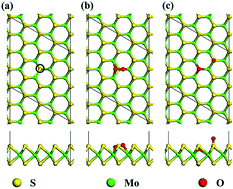Atomistic insight into the oxidation of monolayer transition metal dichalcogenides: from structures to electronic properties†
Abstract
Monolayer transition metal dichalcogenides (TMDs) stand out in two-dimensional (2D) materials due to their potential applications in future microelectronic and optoelectronic devices. In experiments, field effect transistors (FET) based on the MoS2 monolayer are sensitive to environmental gases, especially O2. Thus, the oxidation of monolayer TMDs is a critical concern. By first-principles calculations, we reveal that a perfect single-layer sheet of TMDs stays intact when exposed in O2 due to the weak physical adsorption of O2. However, O2 can be chemically adsorbed onto the monolayer of TMDs (including MoS2, MoSe2, MoTe2, WS2, WSe2, and WTe2) with single vacancies of chalcogen, which are the most common defects in realistic TMD materials. The adsorption configurations and dissociation behavior of the O2 molecule at vacancy sites, as well as the possible diffusion behavior of oxygen adatoms on the TMD monolayer surface were explored. Oxidation significantly influenced the electronic properties of a defective MoS2 monolayer, while other defective TMD monolayers (especially MoTe2 and WTe2) suffered less from oxidation. Our theoretical results provide valuable atomistic insight into the oxidation of TMD monolayers and are useful for the future design of TMD-based 2D devices.


 Please wait while we load your content...
Please wait while we load your content...